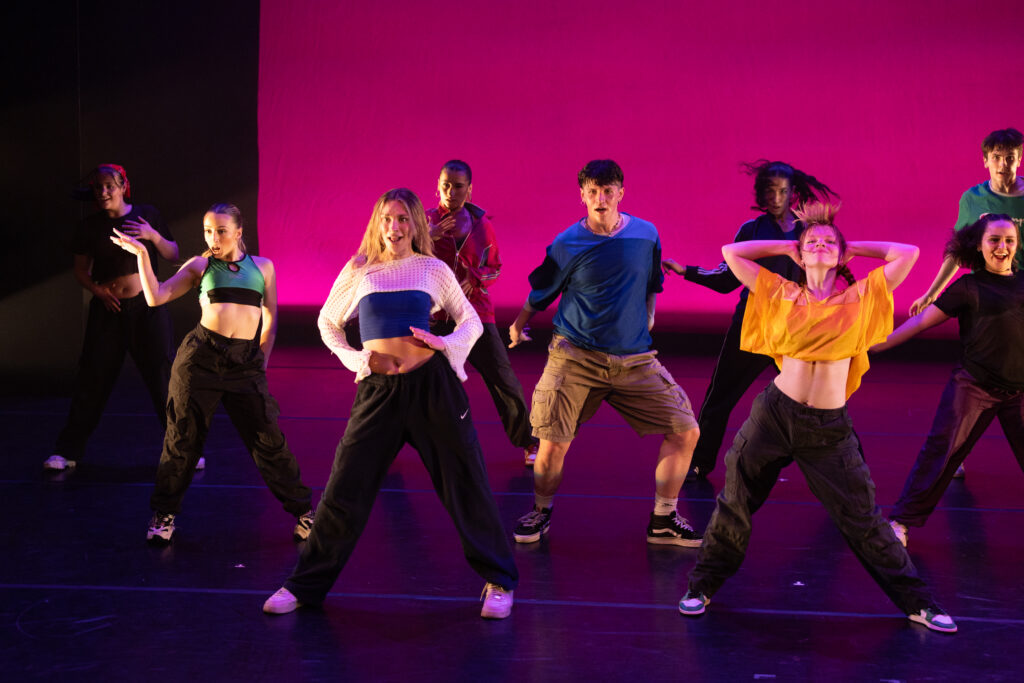The dance world is changing. And at Marymount Manhattan College, the Department of Dance’s newly reimagined curriculum is reflecting those changes with an eye towards equity. Until this year, MMC’s BA and BFA programs focused heavily on ballet and modern techniques. Now, the curriculum requires incoming students to place equal weight on modern, ballet, jazz (including a course entitled Embodied Africanist Aesthetics), and improvisation, giving dancers a chance to experience a breadth of movement practices before diving into their chosen concentrations. “The focus on Western concert-dance was very strong, and the opportunities to delve deeply into African diasporic forms and vernacular and theatrical jazz were fewer, and happened later for students,” says Betsy Cooper, MMC’s chair of dance.
This evolution has coincided with a college-wide shift in general education requirements. Not only does this give dancers the freedom to take more elective courses and minor or double-major in fields outside of dance, but it also frees up students’ schedules to focus on their concentrations more fully. MMC’s dance faculty believes that the sum of these changes will allow students to be better prepared for what comes next, no matter what their goals are after graduation. “It’s a recognition that the field is diverse already,” says Cooper. “How do we speak to that, and prepare our students not only for their careers but to be leaders and changemakers, as well?”

 Marymount Manhattan College dance students performing a work by Dolly Sfeir. Photo by Rosalie O’Connor, Courtesy Marymount Manhattan College.
Marymount Manhattan College dance students performing a work by Dolly Sfeir. Photo by Rosalie O’Connor, Courtesy Marymount Manhattan College.
A More Personal Audition Process
The values behind MMC’s curricular changes are influencing more than just the classes students take—they’re also reflected in the revamped audition process. “In really thinking about this idea of aesthetic equity between technical forms, we shifted our auditions,” says MMC associate professor of dance Nancy Lushington. “Now, when students come to campus to audition, we no longer start with ballet. We recognize that that’s going to be some students’ happy place, but for other students, it might shut them down.” Instead, auditions begin with a somatic warm-up, and then segue into sections focusing on modern, ballet, jazz, and hip-hop techniques, culminating with a group-based composition assignment.
Applicants also go through an interview process, allowing faculty members to learn about their interests outside of dance. It’s a two-way street: This helps dancers to understand if MMC is the right fit for them as a liberal arts college rather than a standalone conservatory. “Our training is just as strong as a conservatory, but it’s more than that,” says Cooper. “It’s preparing artists for an evolving field.”
Expanded Jazz Offerings
For the past two years, MMC has required all dance students to take Embodied Africanist Aesthetics, a course that includes a mix of hip hop, Latin jazz, and West African and Afro-Caribbean forms. This year’s updates to the curriculum include moving Embodied Africanist Aesthetics (“EAA”) into the Jazz Dance Concentration and adding more levels. “We’ve added more of it to our school, and solidified it in our program,” says MMC assistant professor of dance Jazelynn Goudy, “versus making it an extra class floating outside of a concentration.”
 Marymount Manhattan College dance students performing a work by Adesola Osakalumi. Photo by Rosalie O’Connor, Courtesy Marymount Manhattan College.
Marymount Manhattan College dance students performing a work by Adesola Osakalumi. Photo by Rosalie O’Connor, Courtesy Marymount Manhattan College.
Goudy says that students in other concentrations can also take additional levels of EAA as electives. For Goudy, including EAA in the Jazz Dance Concentration shows students how expansive jazz is as a genre—and how many of its styles have roots in Black and Brown communities. “You have your EAA, and then your theatrical jazz, where you get to wear your LaDucas and PERFECT your fan kicks and pirouettes, and you have Frank Hatchett technique, and teachers who used to dance with the Fosse folks, and then you’re also learning Waacking and Lindy Hop partnering,” she adds.
What These Changes Mean
Overall, the upgrades to MMC’s dance and GE curriculum mean that students have more freedom to create individualized courses of study, follow their passions, and explore beyond their comfort zones. And the shift in general education requirements means that BFA students have more space to take on minors or double majors; BA students can now take more technique classes, and are able to audition to perform in more than one piece per semester. Students also have more room to take on off-campus internships and make the most of MMC’s New York City home. And this is all in addition to MMC’s numerous performance opportunities.
 Marymount Manhattan College dance students performing a work by Zvi Gotheiner. Photo by Rosalie O’Connor, Courtesy Marymount Manhattan College.
Marymount Manhattan College dance students performing a work by Zvi Gotheiner. Photo by Rosalie O’Connor, Courtesy Marymount Manhattan College.
MMC’s dance faculty believe that these changes will enable students to be more adaptable after graduation. “There are fewer repertory companies, so we’re preparing students to enter the gig culture,” says Cooper. And some MMC alumni choose to follow nonperformance career paths: Lushington cites the executive director of the Bessie Awards and the chief archivist of New York City Ballet as examples.
The dance faculty hope that these changes will help prepare even more students to take their careers into their own hands. “I believe this program shifting will allow them to be courageous and brave to explore, as well as to create something new,” says Goudy. “As the dance world changes, many dance programs, not just Marymount’s, are striving to elevate the field and bring attention to its diversity.”
For more information on Marymount Manhattan College’s dance programs, click here.



GIPHY App Key not set. Please check settings